Last updated: January 10, 2023
Article
50 Nifty Finds #9: Green Stamps
Described by some as "the greatest propaganda campaign ever launched by the federal government to exploit the scenic wonders of the United States," the national park stamps issued by the US Post Office Department in 1934 became one of the most recognized series of US stamps. Despite being in the middle of the Great Depression, over one billion of the 10 national park stamps were printed in under two years—including the first US postage stamp designed by a woman.
Although it's been reported that National Park Service (NPS) Director Stephen T. Mather first called for a series of national park stamps in 1925, American stamp collectors were ultimately responsible for their creation. Joined by Senator Homer T. Bone and Representative Wesley Lloyd, philatelic (stamp-collecting) societies presented a petition in November 1933 to President Franklin D. Roosevelt in favor of a stamp series "picturing scenes in national parks and national monuments." They had a receptive audience as both President Roosevelt and Secretary of the Interior Harold L. Ickes were avid stamp collectors.
Under the headline "Scenic Stamp Movement Revived," the December 1933 Park Service Bulletin noted, "For a number of years various efforts have been made for a series of national park postage stamps issued by the Post Office Department. It is hoped that the present movement will result in the issuance of such stamps." An editorial in the Evening Star (Washington, DC) stated, "Perhaps the slogan, "See America First" could have no better or more comprehensive application. One of the fundamentals of an intelligent patriotism, surely, would be served by the device. It would add to the people's knowledge of their domain."
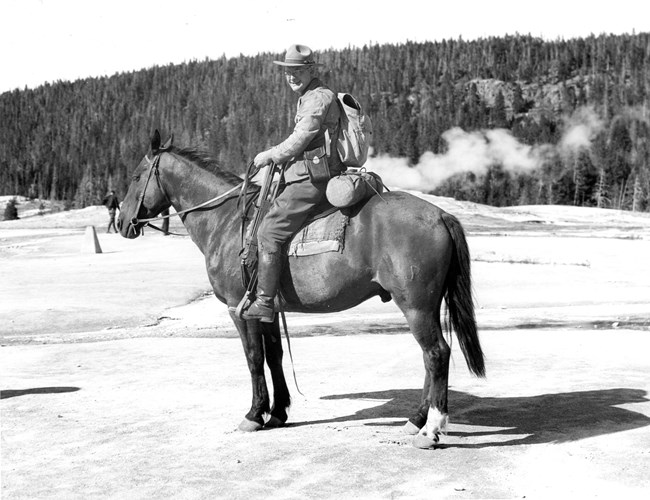
NPS Director Arno B. Cammerer ordered NPS chief photographer George A. Grant to select photographs for possible use. Some reports suggest that Ickes proposed 12 stamps. It's not clear how many photographs Grant reviewed or selected for consideration. In a 1962 oral history interview, Grant recalled, "We had an awful time making those selections." He even reduced the negatives to postage-stamp size to determine which would look good at that scale.
Grant's recollection that "Secretary Ickes was quite interested in it at the time" is echoed in a 1933 newspaper article that noted, "President Roosevelt and Secretary Ickes are stamp collectors and between them they do most of the deciding about the new stamp designs." Five of the selected images were by Grant himself. The rest were by Ansel Adams, J.E. Haynes, Asahel Curtis, H.L. Bradley, and the Thompson Company.
In spite of the early news reports, an Evening Star article noted that as late as April 29, 1934, it still wasn't clear that the series would be issued. With a presidential series of stamps also proposed, it was possible that the Bureau of Engraving and Printing wouldn't have the capacity to do both. The article noted, "An important conference held last month between President Roosevelt, Postmaster [General] James A. Farley, and Secretary Ickes may result in approval of the park series." On May 6, 1934, the Evening Star pushed the idea further, publishing a list of 10 parks to be featured and photographs as "decorative suggestions" for the stamps.
On May 16, 1934, Farley authorized the national park stamps, "in conjunction with the Interior Department's observing of this year as National Park [sic] Year." The parks to be represented were Yosemite, Grand Canyon, Mount Rainier, Mesa Verde, Yellowstone, Zion, Acadia, Sequoia, Glacier, and Great Smoky Mountains in denominations of 1¢ to 10¢, respectively. Remarkably, the Bureau of Engraving and Printing, directed by Alvin W. Hall, designed and printed the first stamp in just two months.
The April-May 1934 Park Service Bulletin noted, "For a number of years efforts have been made to have stamps of this nature issued, and it is gratifying that they are to come out during this, the National Parks Year."
The National Parks Year issue was the first series devoted entirely to scenic views of national parks. They were made in a larger size (.84 by 1.44 inches) to better show off the park images. The stamps were issued in perforated sheets of 50. As described below, a few stamps were also issued in unperforated sheets of 200 as special souvenirs.
The national parks series was reissued on March 15, 1935, in ungummed, unperforated sheets of 200 and sheets of 20 panes of six stamps each. Farley was criticized in the press for special printings like these, which they called "Farley's Follies." The national parks series was the last of his special printings.
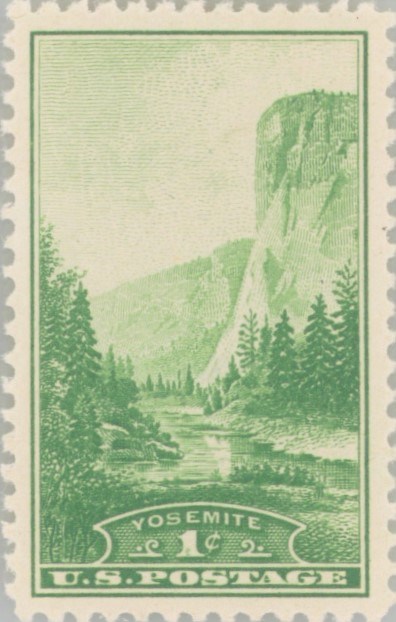
Yosemite 1¢ Stamp
The vertical one-cent stamp is printed with green ink. The scene features El Capitan on the right. A tree-lined river runs through the middle of the image. In a solid green panel across the bottom of the stamp is the inscription "US postage" in white lettering. Resting on this base is a dark panel with curved top and ends, within which is the title "Yosemite" in white Gothic font. Below the title is the denomination designation 1¢ in white and flanked by white line ornaments. The stamp is enclosed in a narrow double-line border.
The stamp features a photograph by Ansel Adams. Victor S. McCloskey Jr. designed the stamp. J.C. Benzing engraved the image and W.B. Wells engraved the lettering. Eight different plates were used to print 80 million stamps.
This stamp was released on July 16, 1934, at post offices in Yosemite National Park and Washington, DC. The first-day sales at Yosemite exceeded 250,000 stamps with more than 26,000 covers canceled.
The US Post Office Department also printed a sheet of six Yosemite stamps (without perforations) as a souvenir of the Trans-Mississippi Philatelic Exposition and Convention held in Omaha, Nebraska, from October 8 to 14, 1934. It first went on sale on October 10, 1934, at the convention. Collectors who didn't attend the convention could order a set from the Post Office Department, but the souvenir set was not sold in post offices after the convention.
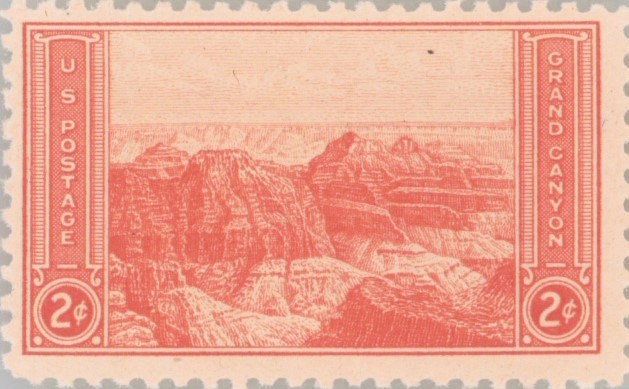
Grand Canyon 2¢ Stamp
The horizonal two-cent stamp is printed with red ink. The image is the Grand Canyon showing the temples of Deva, Brahma, and Zoroaster, and Bright Angel Canyon. On either side of the stamp are upright panels containing the words "US postage" at the left and "Grand Canyon" at the right in white letters arranged vertically within an ornamental framework. Within circular panels with white borders and solid background in each lower corner is 2¢ in white. The image is surrounded by a narrow double-line border.
The stamp features a 1930 photograph by Grant. McCloskey designed it. L.S. Schofield engraved the image and Wells engraved the lettering. Eight different plates were used to create 75 million stamps.
This stamp was released on July 24, 1934, at post offices in Grand Canyon National Park and Washington, DC.
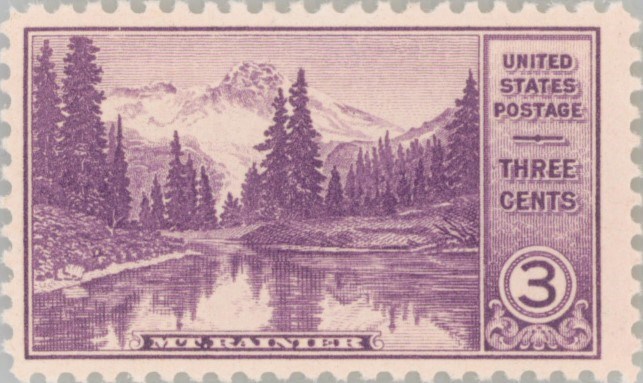
Mount Rainier 3¢ Stamp
The horizontal three-cent stamp is printed with purple ink. The image is Mount Rainier with Mirror Lake in the foreground. The mountain peak and surrounding trees are reflected in the lake. A panel on the right has the words "United States postage" in shaded lettering arranged in three horizontal lines. Underneath is a separating line and the words "three cents" in shaded letters printed in two lines. Resting on an acanthus leaf ornament in the bottom right corner is a white disk containing the solid purple numeral "3." In a narrow panel at the base is the name "Mt. Rainier" in white letters on a solid background. The image is surrounded by a narrow double-line border.
The stamp features a photograph by Asahel Curtis. McCloskey designed the stamp and Benzing and Wells engraved the image and the numbering, respectively. Eight different plates were used to print 85 million stamps.
This stamp was released on August 3, 1934, at post offices in Longmire, Washington, and Washington, DC. The US Post Office Department also printed a sheet of six Mount Rainier stamps (without perforations) as a souvenir of the annual convention of the American Philatelic Society, held in Atlantic City, New Jersey, from August 28 to September 1, 1934. The sheet was not sold at post offices.
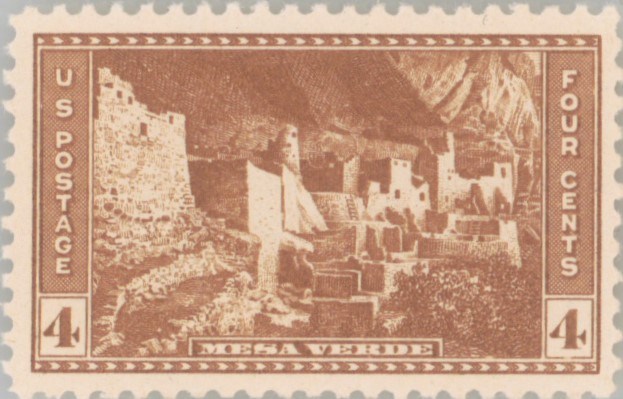
Mesa Verde 4¢ Stamp
The horizontal four-cent stamp is printed with brown ink. The image features Cliff Palace. At the bottom is a narrow brown panel, outlined in white, containing the words "Mesa Verde" in white letters. The left side has a brown rectangular panel with the words "US postage" in white shadowed letters, arranged vertically, above a white rectangle with a brown numeral "4" inside it. The right side has a brown rectangular panel with the words "four cents" in white shadowed letters, arranged vertically, above a white rectangle with a brown numeral "4" inside it. The image is enclosed in a double-line border which is widened at the top and bottom of the stamp to form a narrow panel containing a row of repeating small arrow-like ornaments in white on a brown background.
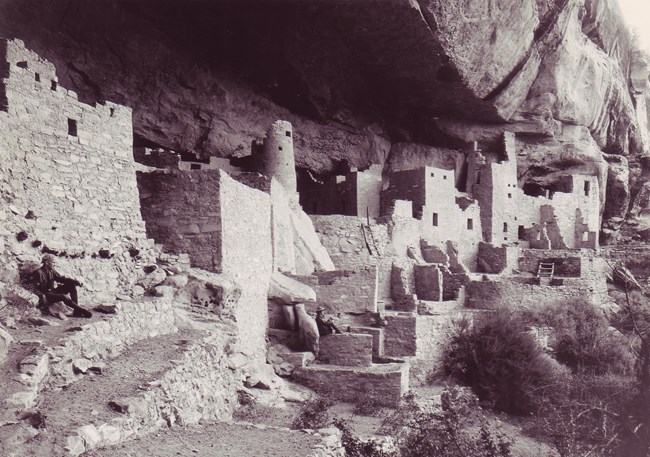
The Bureau of Printing and Engraving was ordered to create the Mesa Verde stamp on May 16, 1934. McCloskey created the design from a photograph by Grant. C.T. Arlt engraved image and E.H. Helmuth engraved the frame and numerals. The die and proof were approved on September 14. Printing began on September 18 and the Post Office received them two days later. Four different plates were used to print 15 million stamps.
This stamp was released on September 25, 1934, at post offices at Mesa Verde National Park and Washington, DC. First-day sales at Mesa Verde were 84,602 stamps and 51,682 covers were canceled. Post offices in Washington, DC sold 108,127 stamps and canceled 21,729 covers. A total of 19,178,650 Mesa Verde stamps were issued.
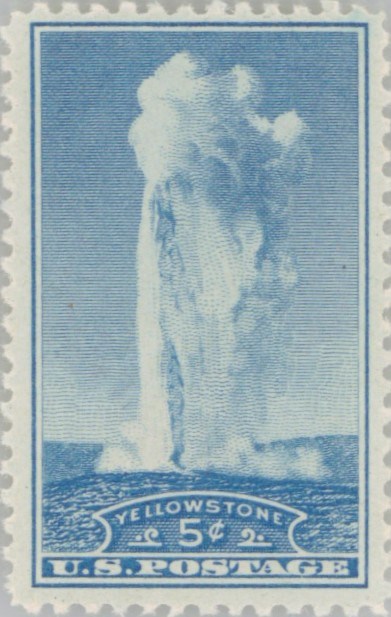
Yellowstone 5¢ Stamp
The vertical five-cent stamp is printed with blue ink. The image is an erupting Old Faithful geyser, with its column of hot water high in the air. In a solid blue panel with white edges across the bottom of the stamp are the words "US postage" in white letters. Above that is a lighter blue panel with curved top and ends with the title "Yellowstone" in white letters and the 5¢ denomination, also in white. The image is surrounded by a narrow double-line border.
The stamp was created from a photograph by Jack Ellis Haynes submitted by the NPS. Known as J.E. Haynes, he took over the Haynes Photo Studios in Yellowstone from his father F. Jay Haynes in the 1920s. Haynes Studios owned the copyright to the image. McCloskey designed the stamp. Arlt engraved the image and Wells engraved the lettering. Four different plates were used to print the first order of 35 million stamps. It's not clear if more stamps were ordered later.
The Yellowstone stamp was issued on July 30, 1934, at post offices in Yellowstone National Park and Washington, DC. Postmaster General Farley acted as postal clerk at Yellowstone to sell the first stamp block to Senator Joseph C. O'Mahoney. In turn, he gave it to William Henry Jackson, age 91. Jackson, the first person to photograph Old Faithful in 1871, donated the stamp to the park's museum.
Some critics considered the vertical Yellowstone and Yosemite stamps to be the most beautiful in the series.
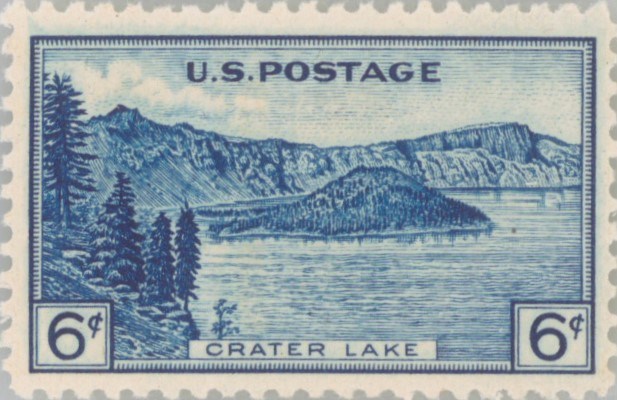
Crater Lake 6¢ Stamp
The horizontal six-cent stamp is printed with blue ink. The image is a view of Crater Lake showing trees on the shore and portions of the surrounding rim and Wizard Island. Glacier Peak and the Devils Backbone are in the distance. The words "US postage" in dark blue lettering are printed in the cloudy sky. White rectangular panels with blue double-line borders in each lower corner have the dark blue 6¢ denomination. A narrow white horizontal panel at the base of the stamp has the title "Crater Lake" in small dark blue letters.
On May 16, 1934, the US Post Office Department announced stamps for Zion and Sequoia national parks. In the end, Crater Lake was featured instead of Sequoia. The change resulted from lobbying by Oregon's US Representative General Martin. In June 1934, he sent a telegram to the state's chamber of commerce stating, "Have been successful in obtaining recognition for the Crater Lake stamp. I was assured today the denomination will be 8¢."
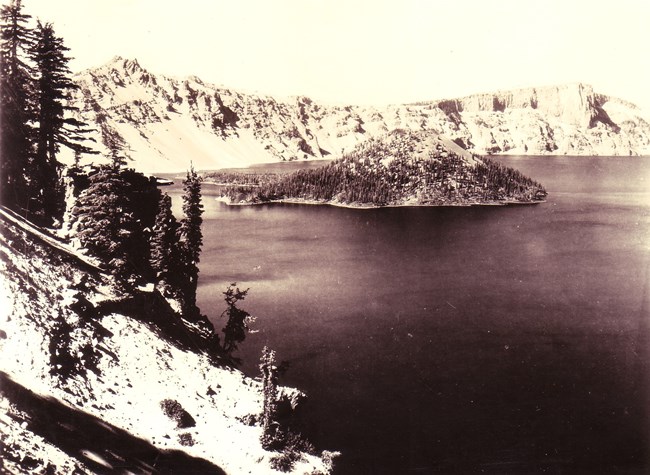
The Post Office Department determined that the olive green of the 8¢ denomination would not work well for the Crater Lake scene. The Crater Lake and Zion stamps were switched to 6¢ and 8¢ denominations, respectively. On May 16, 1934, the Bureau of Engraving and Printing was instructed to prepare the 6¢ Crater Lake stamp, to be printed in orange. McCloskey submitted several designs on August 9 based on a photograph by Grant. One design, with slight modifications, was selected.
D.R. McCleod engraved the frame and lettering, and Schofield engraved the Crater Lake vignette. The proof, printed in orange, wasn't approved and they decided to try blue to match Crater Lake itself. Farley approved the blue proof on August 29, 1934. Printing started that day and the first delivery to post offices arrived two days later. A sheet (without perforations) was sent to President Roosevelt and other dignitaries.
The stamp was issued September 5, 1934, at post offices in Crater Lake National Park and Washington, DC. First-day sales at Crater Lake were 57,865 stamps and 45,282 covers were canceled. Washington, DC post offices sold 62,134 stamps and canceled 19,161 covers. A total of 16,923,350 stamps were issued.
Some stamp collectors complained that, despite the color change, the stamp didn't do the park justice; the water of Crater Lake was almost white while the walls of the crater were a deep blue. This is likely because the original plan was to print with yellow ink which required the engraver to create deeply recessed plates with widely separated lines. With the last-minute color change to blue, there wasn't time to engrave new plates.
On March 15, 1935, special sheets (without perforations) were created for sale at the Philatelic Agency in Washington, DC. Only 7,270 of the 200-stamp sheets sold. The rest were returned to the Bureau of Engraving and Printing where they were gummed and perforated then sent back to the Post Office for sale. The four-stamp blocks were more popular, and 67,644 were sold. A total of 1,724,576 were issued. Those not sold by June 15, 1935, were redeemed at the Bureau of Engraving and Printing and destroyed.
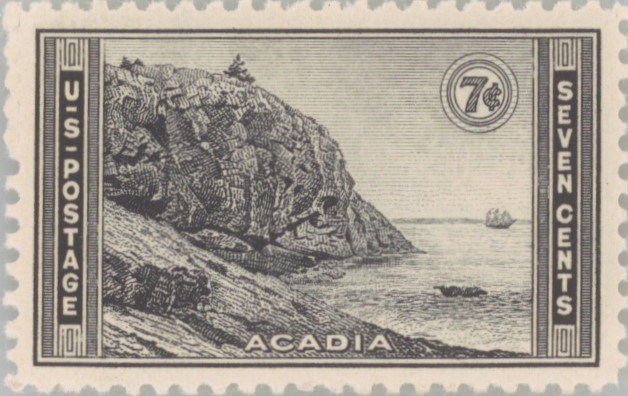
Acadia 7¢ Stamp
The horizontal seven-cent stamp is printed with black ink. The image is a view of Great Head, a rocky promontory on the shore of Acadia National Park. At the bottom the title "Acadia" is printed in white letters. The left side of the stamp has a vertical panel with dark background bordered by paneling in a lighter shade on either side and ornamental devices at the top and bottom. The wording "US postage" in white letters is arranged vertically inside the panel. The right panel is the same as the left but has the words "seven cents" in white letters, arranged vertically. The 7¢ denomination is contained within a white circle bordered by several black lines, is in the sky above a boat floating on the ocean. The image is surrounded by a narrow double-line border.
McClouskey designed the stamp based on a photograph by NPS employee H.L. Bradley. Benzing engraved the image. Helmuth and McLeod worked on the lettering. Four different plates were used to print 15 million stamps.
The stamp was issued on October 2, 1934, at Bar Harbor, Maine, and Washington, DC.

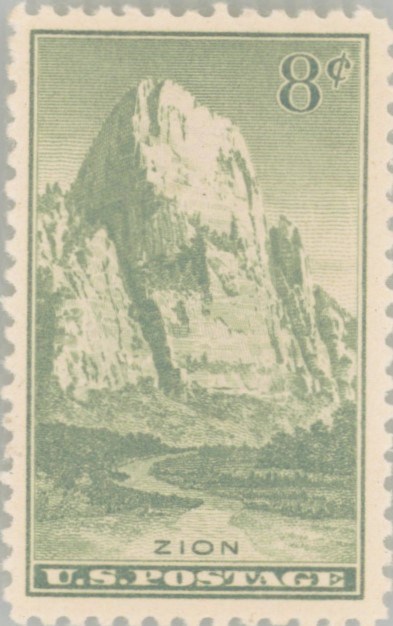
Zion 8¢ Stamp
The vertical stamp is printed with gray-green ink. The image is of the Great White Throne in the background with a river and trees in the foreground. Below the image is the title "Zion" in dark green lettering. Underneath the title is a narrow dark green panel with a white border. The words "US postage" in white lettering are inside the panel. The dark green 8¢ denominations is in the sky above and to the right of the Great White Throne. The image is surrounded by a narrow double-line border.
McClouskey designed the stamp based on an image by Grant. Arlt engraved the picture and McCleod the lettering. Four different plates were used to create 15 million stamps in the initial printing.
The stamp was issued on September 18, 1934, at post offices at Zion National Park and Washington, DC.
The Zion stamp was noteworthy to collectors because of its color. It was described as "olive green" or "like the color of winter apples." For the previous 30 years, the 8¢ postages stamp in the United States had been "plain olive" in color.
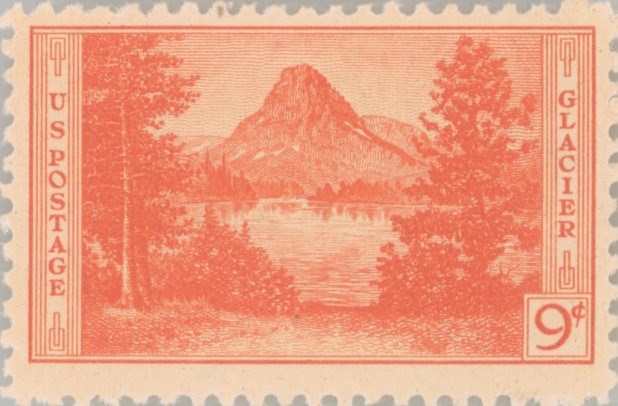
Glacier 9¢ Stamp
The horizontal nine-cent stamp is printed in shades of pink ink. The image is Mount Rockwell in the distance and Two Medicine Lake with bordering forest trees in the foreground. Arranged vertically on either side are white panels ruled with three sets of vertical lines on either side of the words. The left panel reads "US postage" and the right panel "Glacier" both in pink ink. A small white square, with a pink double-line border, displays the pink 9¢ denomination.
McClouskey designed the stamp based on a 1932 photograph by Grant. Arlt engraved the image and Wells did the lettering. Four plates were used in the original printing of 15 million stamps.
The stamp was issued on August 27, 1934, at post offices in Glacier National Park and Washington, DC.

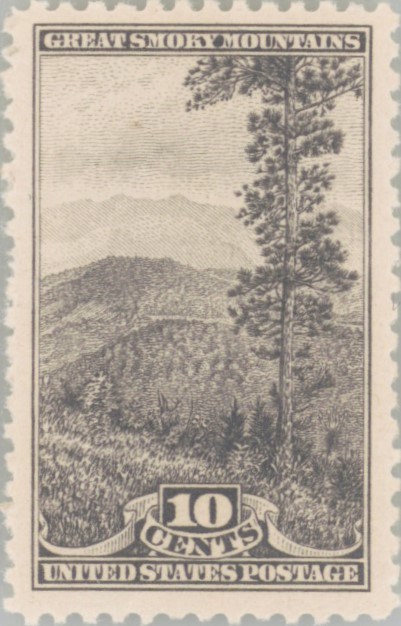
Great Smoky Mountains 10¢ Stamp
The vertical ten-cent stamp is printed with gray-black ink. The image looks across grassy hills, past a large off-center tree, towards Mount Le Conte from Chimney Tops Mountain. In a dark gray narrow panel across the top of the stamp are the words "Great Smoky Mountains" in white lettering. In a similar panel on the bottom of the stamp are the words "United States postage" also in white. Directly above the panel is a curved ribbon panel with the word "cents" in gray-black letters in the center fold of the ribbon. Immediately above, in a dark rectangular panel, is the white numeral "10." The image is surrounded by a narrow double-line border.
A photograph by the Thompson Company, which owned the copyright to the image, was used in this stamp. It was designed by Esther A. Richards, a Philadelphia artist temporarily hired by the Bureau of Engraving and Printing. She was the first woman to design a US postage stamp, which also makes the Great Smoky Mountains stamp the first designed by a woman. Schofield engraved the image and Helmuth engraved the lettering. Four different plates were used for the original printing of 20 million stamps.
The stamp was issued on October 8, 1934, at post offices in Gatlinburg, Tennessee, and Washington, DC.
Several newspaper accounts reported that the Great Smoky Mountains stamp was to be printed in yellow ink, the traditional color for a 10¢ stamp. However, on October 2, 1934, it was reported that the color was changed to slate gray. The article noted, "This color change will give the new stamp a more distinctive tint, one that is more in artistic conformance with the stamp's central subject." The stamp received some criticism for not being as clear as it should have been, but critics acknowledged that "gray does not lend itself to outstanding marks of outline."
Sources:
-- (1934, July 31). "Farley Sells First National Park Stamps." The Atlanta Constitution (Atlanta, Georgia), p. 18.-- (1934, September 29). "The World of Stamps." Weekly Town Talk (Alexandria, Louisiana), p. 14.
-- (1934, October 02). "Postage Stamp Collecting." Delaware County Daily Times (Chester, Pennsylvania), p. 7.
-- (1936, May 10). "Secretary Ickes Real Stamp Collector." The Minneapolis Journal (Minneapolis, Minnesota), p. 15.
Associated Press. (1933, July 29). "Roosevelt and Ickes to Design Stamps." St. Louis Globe-Democrat (St. Louis, Missouri), p. 3.
Davis, Ren and Davis, Helen. (2015). Landscapes for the People: George Alexander Grant, First Chief Photographer of the National Park Service. University of Georgia Press.
Fawcett, James Waldo. (1933, November 5). "Stamps." Evening Star (Washington, DC), p. 24.
Fawcett, James Waldo. (1934, May 6). "Stamps." The Sunday Star (Washington, DC), p. 38 and "Gravure Section" (for photos), p. 97.
Fawcett, James Waldo. (1934, May 20). "Stamps." The Sunday Star (Washington, DC), p. 72.
Fawcett, James Waldo. (1934, June 10). "Stamps." Evening Star (Washington, DC), p. 70.
Gay, Ed. (1934, October 14). "Stamp News." Arizona Daily Star, p. 20.
Grant, George A. Oral History Interview. (1962, December 10). NPS Oral History Collection (HFCA 1817), NPS History Collection, Harpers Ferry Center.
Johl, Max G. (1947). The United States Commemorative Stamps of the Twentieth Century, Volume 1, 1901-1935. H.L. Lindquist Publisher.
Kunze, Alfred F. (1934). Stamp Romances: The Lore and Legend Associated with the 1934 National Park Series of Stamps. Washington Stamp Club of the Air, Washington, DC.
Labow, Sol. (1934, April 29). "Stamp News." The Pittsburgh Press (Pittsburgh, Pennsylvania), p. 44.
Lightbody, Edward. (1936, October 27). "Philatelic Column." Stevens Point Journal (Stevens Point, Wisconsin), p. 5.
National Park Service. (1933, December). "Scenic Stamp Movement Revived." Park Service Bulletin, Vol. 3, No. 8, pp. 6-7.
National Park Service. (1934, April-May). "Postage Stamps to Carry National Park Scenes." Park Service Bulletin, Vol. 4, No. 3, p. 12.
National Park Service. (1934, June-July). "National Park Stamps." Park Service Bulletin, Vol. 4, No. 4, pp. 2-3.
Ott, Fred. (1934, September 16). "Seek Stamps, Press for Dedication." Pittsburgh Sunday Sun-Telegraph (Pittsburgh, Pennsylvania), p. 38.
Science Service. (1934, August 5). "It Pays to Advertise. Uncle Sam Resorts to a New Issue of Stamps in Order to Acquaint the People with the Wonders of their Own Country." St. Joseph Gazette (St. Joseph, Missouri), p. 15B.
Smithsonian Postal Museum. (no date). "National Parks Year Issues." Accessed 1/6/2023 at https://postalmuseum.si.edu/exhibition/about-us-stamps-bureau-period-1894-1939-commemorative-issues-1934-1935/national-parks
United States Post Office Department. (1942). A Description of United States Postage Stamps. US Government Printing Office, Washington, DC.
Tags
- acadia national park
- crater lake national park
- glacier national park
- grand canyon national park
- great smoky mountains national park
- mesa verde national park
- mount rainier national park
- sequoia & kings canyon national parks
- yellowstone national park
- yosemite national park
- zion national park
- nps history
- nps history collection
- postage stamp
- hfc
- george a. grant
- arno cammerer
- harold ickes
- art
